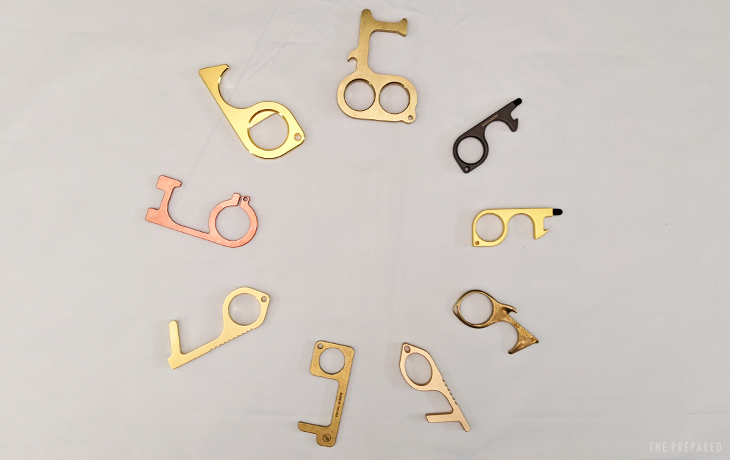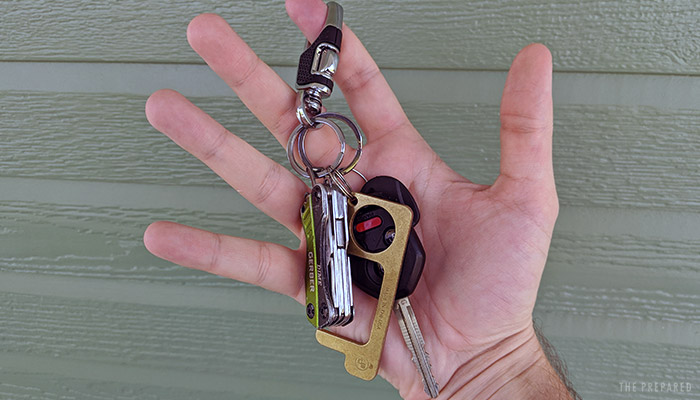This is a growing category of products — particularly since COVID — that doesn’t have a solid name yet. Common names include sanitary keychains, no-touch keychains, no-touch tools, no-contact door openers, etc.
But the idea is the same: something you hold as an intermediary that can do most of the normal stuff you’d normally do with your hands, such as opening a door to the store or using an ATM.
Most of these no-contact tools are in the $5-20 range and relatively simple to make and sell. That means the market is flooded with lots of hard-to-differentiate options and competitors offering the same white-labeled versions from the same set of factories. Searching for “hygiene keychain” on Etsy, for example, returns 645 results.
And because people are scared from COVID, unethical scammers sell “antimicrobial” sanitary keychains that are just plastic painted to look like copper or brass. (Note: labeling a product as antimicrobial/antibacterial is actually regulated by the government, so some legit products will actually skip using that label because they don’t want the regulation.)
Brass and copper are the best materials for these tools because those metals are naturally self-cleaning — a neat process called the Oligodynamic effect. Since the whole point is to touch dirty things, it makes sense that you’d want to avoid plastic and other materials that keep germs on their surface for many days.
Sure, contamination like COVID will stay on brass or copper for up to four hours, but some level of self-cleaning is better than nothing. Some other product reviewers like The Wirecutter believe the lack of instant sanitation makes the whole product category useless, recommending gloves instead — but we think you’re smart enough to remember that brass/copper isn’t a magical solution, just a good one.
We had never used a tool like this before, so it was time to buy a bunch of the most popular models in the market and use them in real life to see what’s what. Based on 15 hours of research and weeks of testing, our picks are:
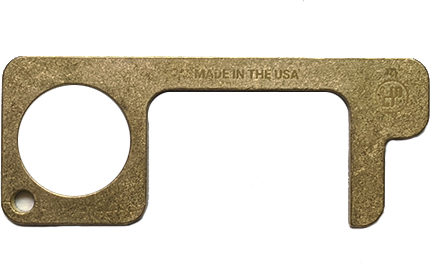
Best for most:
StatGear Hygiene Hand Lite
The StatGear Hygiene Hand Lite was a Kickstarter that formed right after COVID took over the world. They hit their pledge goal on the first day, eventually raising $585k from 11,000 people. That probably had more to do with people’s panic at the time, but it turned out to be a great product, too — it felt like one of the winners as soon as we had all the contenders side by side.
The original, non-Lite version is twice the weight (2 vs 1 oz) and almost twice the cost. But the Lite was good enough to win on its own, so we see no point in the heavier and pricier version. The Lite’s size, shape, and weight is middle of the road among the market. In our real-world testing, it was small enough to not be a nuisance on our keychain while still big enough to do core tasks without compromise. It handled any doors, buttons, and touch screens we ran across. Also comes with a freebie retractable carabiner to attach the tool to a backpack, purse, etc.
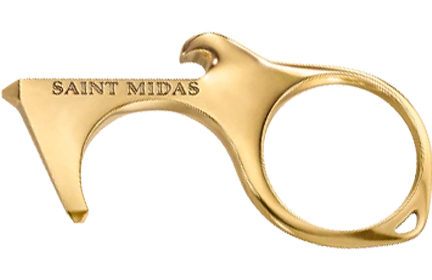
Best compact size:
Saint Midas Touch
The Saint Midas Touch was our favorite among the smaller half of contenders. To be frank, the bar wasn’t very high as most of the small contenders were pretty disappointing. Unlike the other smaller options, the Midas handled almost every need we ran across — it only struggled with unusually-large doors/objects that couldn’t fit in it’s 1″ ‘grabber’ diameter. You do notice the size and weight savings compared to the StatGear; the Midas blended in more naturally with common keys and has some thoughtful design touches that make it more glamorous than the standard block of metal. The finger hole diameter still felt natural for a wide range of hands.
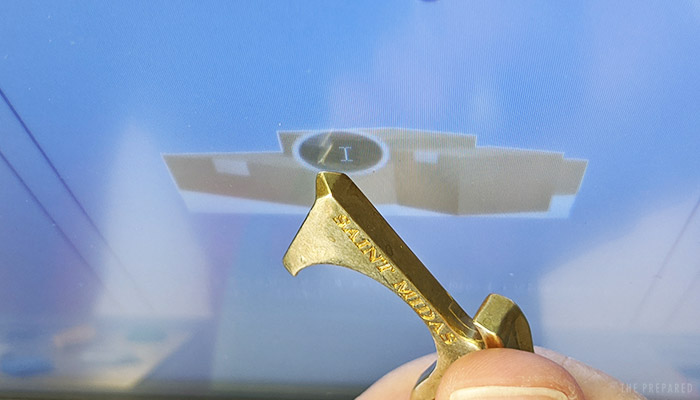
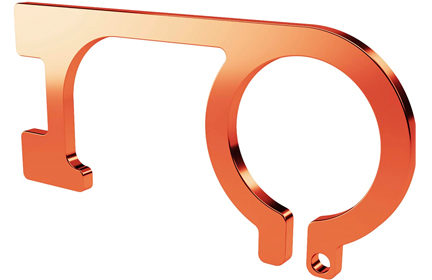
If you want copper:
Aviano
The Aviano stands out (even in the pictures) as the only visibly-copper model. Most products came in brass, which is just an alloy of copper and zinc that’s essentially the same except for a golden color. There is some evidence, however, that copper self-cleans more quickly than brass. So if you specifically wanted copper, although the Aviano didn’t win overall, it did still perform well enough to not be a ‘loser.’ We liked the slit in the finger hole as a sort of quick-attach system — you can slide it onto a belt loop or similar. What we didn’t like: it’s a little large, and the dual “noses” at the front are the same length, which means if you approach a touchscreen at a 90-degree angle, both noses hit the screen in two different places.
The competition and how we chose what to test
We bought and field tested:
- Aviano ($24) (May be out of stock or discontinued)
- Jingolden ($9) (May be out of stock or discontinued)
- JLIAN MIOR ($9) (May be out of stock or discontinued)
- KeySmart CleanKey ($25)
- Kingsbom ($14) (May be out of stock or discontinued)
- Midas Touch ($20)
- Peel ($35)
- StatGear Hygiene Hand Lite ($14)
- Z-Key ($28) (May be out of stock or discontinued)
For comparison purposes, we also bought a few knockoffs and alternative ways to solve the same problem, like the plastic clamshell Germ Nerd.
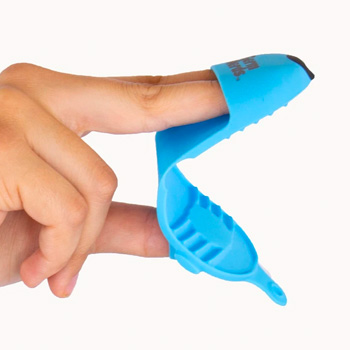
We first decided to ignore anything in the market that didn’t at least claim to be made of copper or brass, since the lack of self-cleaning defeats a lot of the purpose.
That narrowed the pool of contenders down quite a bit. From there, we focused on the products with the highest reviews and those most often seen in ecommerce stores and social media ads. We also skipped models that looked super tiny (and thus not very useful) or too big (since it rides on your keychain, after all.)
Since many of these products are actually rebranded trinkets from a small group of manufacturers, we tried to “de-duplicate” by picking the most common version. So we may have chosen brand X, but our thoughts on brand X apply to every other brand that slaps their label on the same exact underlying product.
Weights, sizes, and materials

We were surprised by the wide range of sizes and weights once we had all of them laid out side by side. So we started by weighing each to compare to their marketing claims:
| Actual weight (ounces) | Size (inches LxWxH) | |
|---|---|---|
| Aviano | 1.1 | 3.5 x 1.5 x 0.16 |
| Jingolden | 0.9 | 3.4 x 1.1 x 0.2 |
| JLIAN MIOR | 0.8 | 2.8 x 1.2 x 0.16 |
| KeySmart CleanKey | 1.7 | 3.5 x 1.4 x 0.2 |
| Kingsbom | 0.7 | 2.8 x 1.2 x 0.16 |
| Peel | 2.4 | 3.5 x 1.8 x 0.16 |
| Saint Midas Touch | 0.9 | 2.8 x 1.4 x 0.3 |
| StatGear Hygiene Hand Lite | 1.0 | 3.2 x 1.2 x 0.12 |
| Z-Key | 3.5 | 3.4 x 2.5 x 0.5 |
The contenders naturally kind of fell into two sizes of small and large. The StatGear (dead middle in the picture above) is an example of where the line is between the small and large category: 1 ounce and around 3.2 x 1.2 inches.
Some of the products, especially the smaller and cheaper ones, instantly set off our warning flags because they did not look like real metal, let alone proper copper or brass. All of the products were marketed as brass, except for the copper Aviano.
So we used common DIY tests to detect these metals, such as using a magnet (which can tell if it’s just “plated”) and scratching away the surface to see what’s underneath.

To our surprise, every product that claimed to be copper or brass actually was! The ones that initially looked fake had surface coatings that gave the false impression. Why would a company use real metal and then hide it, especially when the coating makes the product less self-cleaning since the actual brass/copper surface is buried? Who knows 🤦
A few options have a plastic/rubbery tip specifically for touch screens. Those tips do make using touch screens easier, but in the end, we felt they weren’t worth it because the tips fell off (or clearly will soon), got dirty, will dry out and crack, etc.
Field testing
No surprises here: We would put each tool on our actual keychains for a few days to feel what it was like while riding in a pocket and purse, using the tool as we went above our lives.
We also spent a few hours with all of the tools at once, going around to various public areas to test different types of doors, touch screens, public restrooms, elevators, and so on, that way we had a direct and fair comparison.
The biggest takeaway was around the size and shape of the main “hook” area of each tool, and one of the main differences between our recommendations and the rest was how well they handled a wide range of door types.
The smaller keychains are great for being unobtrusive — after all, the more annoying it is on your keychain, the less likely you’ll enjoy it or use it at all. While we liked the smaller form factors, the smaller main opening for grabbing meant that ~50% of the doors we tried in public wouldn’t actually work.
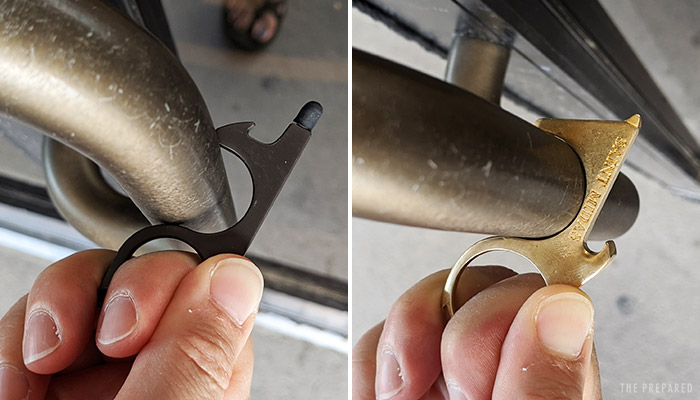
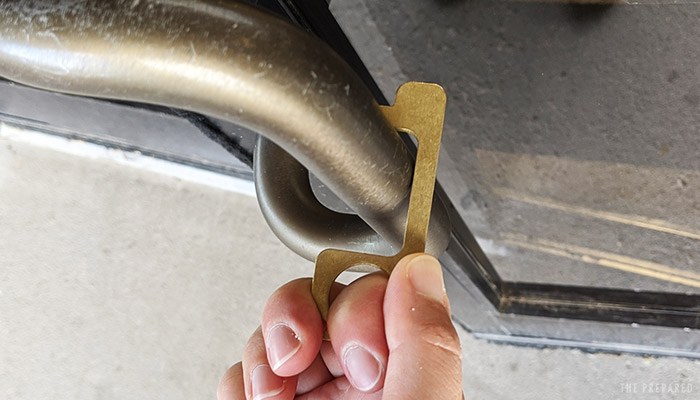
The shape of the main “grabber” made a difference, too. For example, the expensive, large, and heavy Peel Keychain Touch Tool has a short, angled nose, which would consistently slip off handles as we pulled:
A plain ol’ rectangular shape was the best in practice. Some have a kind of nob at the end and some have a negative angle (it points back towards your finger), which can help with retention or carrying grocery bags, but those features didn’t make a huge difference with main tasks.
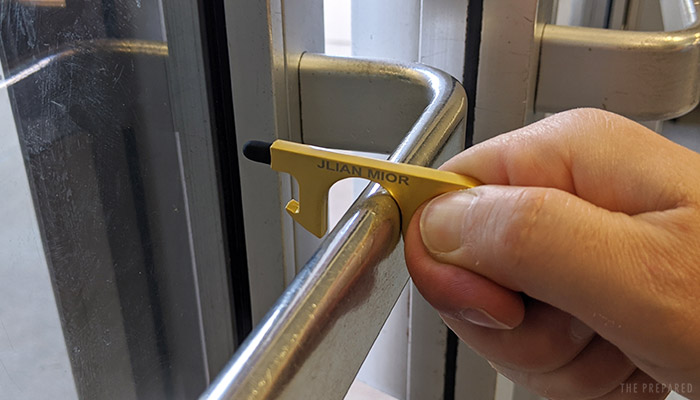
Pushing doors seemed less important than pulling doors since it’s easier to use your body or any object to push. We still tested, and found that the biggest problem was the pressure put against the outside of your finger. Pulling is easy because the force goes into the interior/pad of your finger, which your hand is used to. But pushing puts the force on the exterior side of the finger where there’s less padding over the bone — this created some sore spots after continued use.
We tried lots of touchscreens, from ATMs to post office kiosks to self-checkout lines at Walmart and supermarkets.
The plastic/rubber tips performed the best, but none of those models were good enough to be a main recommendation anyway.
Among the metal options, we noticed that there was a sweet spot regarding how much metal was coming in contact with the screen. Too little (eg. the outside tip of a 90-degree corner) meant that the screen didn’t register the touch. Too much and the screen got confused or you’d click the wrong thing.

Some products advertise bonus uses such as cutting open packages — since people are disinfecting their packages due to COVID, it sounded neat. But it almost never worked in practice. The tape would usually tear and jumble instead of actually cutting.
Contender notes
Quick notes about each of the non-winners:
Jingolden: Seems like a knockoff of the KeySmart. Doesn’t work very well, primarily because the main grabber opening is too small.
JLIAN MIOR: Too small to be effective on some common doors. Has a cheap looking/feeling coating.
KeySmart CleanKey: We loathe companies that automatically spam you just because you bought their product — KeySmart sent us five unwanted emails in one day! We’re not fans of the slanted hook approach, which does make carrying bags easier but interfered with some doors.
Kingsbom: Too small. Plastic tip feels like it won’t stick around long. They coated over the underlying copper material 🙁
Peel: By far the most disappointing of the bunch. As shown in the video earlier in this article, it doesn’t even do a good job of basic door opening.The designers thought it’d be cool to integrate a bottle opener into the same hole you put your finger. This resulted in a hole that’s way too big to be comfortable in your hand (since it had to be big enough for bottle tops) along with the flat edge (which actually flips the bottle caps) that digs into your skin.
Z-Key: This thing is huge. You could even spin it around and use it as brass knuckles, although you’d likely break your hand from a punch. It performed all of the functions well, but the vast majority of people will think this is too big for everyday carry.
